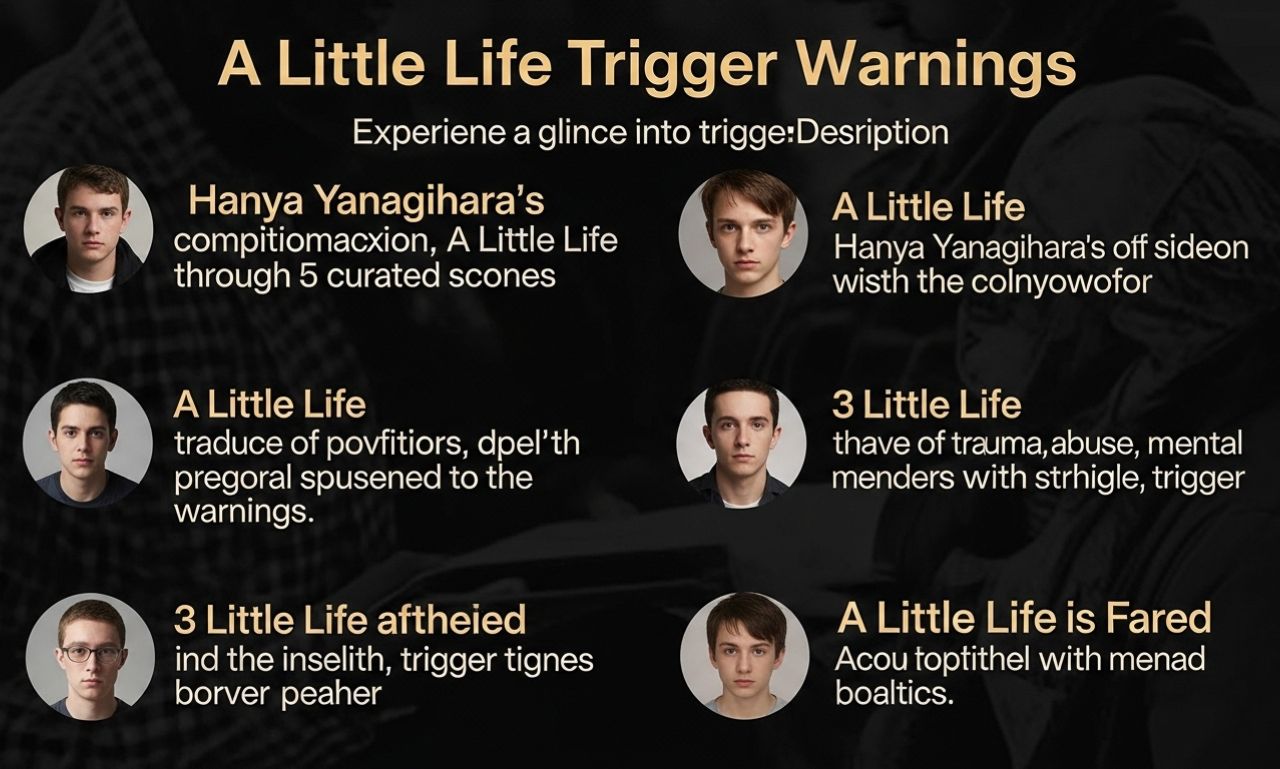Hanya Yanagihara’s A Little Life Trigger Warnings is widely regarded as one of the most emotionally devastating novels of our time. The book is celebrated for its powerful storytelling and unflinchingly raw portrayal of trauma, relationships, and the human condition. But for many readers, it comes with an emotional cost. The novel grapples with themes of abuse, self-harm, and loss, making it a deeply affecting yet challenging read.
This guide explores five scenes in A Little Life that are particularly heart-wrenching. Each scene demonstrates Yanagihara’s ability to shatter hearts while offering trigger warnings for those who may find certain content distressing. Proceed with caution—this emotional tour through the novel’s most impactful moments may weigh heavily on your soul.
Understanding the Emotional Weight of A Little Life Trigger Warnings
Before diving into specific scenes, it’s essential to understand the weight of Yanagihara’s storytelling. On its surface, the book follows four friends—Jude, Willem, JB, and Malcolm—navigating their lives in New York City. But at its core, it centers around Jude St. Francis, a man marked by an unfathomable past. Yanagihara does not shy away from depicting the visceral realities of trauma and resilience, creating a narrative that feels achingly authentic.
Readers should note that this book contains graphic depictions of abuse, sexual violence, self-harm, and suicide. These themes are central to the story, and discussing specific scenes requires an honest examination of these difficult topics.
1. Jude’s Childhood—A Haunting Landscape of Abuse
One of the most harrowing aspects of A Little Life Trigger Warnings is the episodic reveal of Jude’s traumatic childhood. Through flashbacks, we learn about the systematic abuse he suffered at the hands of Brother Luke, a figure who initially seemed to offer refuge. These scenes depict Jude’s manipulation and exploitation in stark and unsettling detail, leaving readers shaken.
A Little Life Trigger Warnings: Sexual abuse, child exploitation
These passages are among the most grueling in the novel, offering a painful lens into Jude’s mistrust of others and deeply ingrained self-loathing. Yanagihara’s writing does not sensationalize but instead affords an unfiltered look at trauma’s long shadow.
2. The Unraveling of Willem and Jude’s Relationship
Willem, one of Jude’s closest companions, becomes an anchor in his tumultuous life. When their bond deepens into romantic love, readers are offered a glimmer of hope. However, their relationship is far from idyllic, as Jude’s inability to confront his trauma creates cracks in their happiness.
The most crushing moment arrives when Willem pleads with Jude to allow him in, to trust their love. Jude’s emotional barriers remain steadfast, leaving both Willem and the readers in despair. This scene showcases the isolating nature of trauma and its power to erode even the strongest bonds.
Trigger Warning: Emotional distress, relationship conflict
This moment underscores the complexities of loving someone irrevocably shaped by their past.
3. The Tragic Accident
Perhaps the most devastating turning point in A Little Life occurs when a car accident claims the lives of Willem and Malcolm, leaving Jude utterly bereft. Through heart-stopping prose, Yanagihara immerses the reader in Jude’s overwhelming grief. The abruptness of Willem’s death shatters not only Jude’s sense of stability but also the emotional footing of the audience.
A Little Life Trigger Warnings: Death, devastating loss
This scene exemplifies Yanagihara’s ability to create intimacy between the readers and her characters, making the loss feel deeply personal.
4. Jude’s Self-Harm and Suicide Attempts
Jude’s struggles with self-harm punctuate much of the book, serving as a devastating outlet for his emotional pain. The narrative reaches a crescendo with explicit descriptions of his attempts to take his own life, forcing readers to grapple with his torment.
These scenes are written with an unflinching eye, detailing the physical and emotional scars that define Jude. Yanagihara captures both the brutality and the heartbreaking reality of self-harm without romanticizing it.
A Little Life Trigger Warnings: Self-harm, attempted suicide
Handled with sensitivity yet brutal honesty, this thread in the narrative demands reflection on the ways trauma manifests and persists.
5. Harold’s Grief
Jude’s adoptive father, Harold, provides a rare source of unconditional love in his life. However, even this relationship is not spared tragedy. After Jude’s eventual death, Harold’s grief becomes a heartbreaking epilogue that underscores the generational ripple effects of pain and loss.
This final note of the novel is perhaps its most poignant. Harold’s reflections on what Jude endured and his inability to save him resonate profoundly with readers, offering closure tinged with deep sorrow.
A Little Life Trigger Warnings: Parental grief, loss of a loved one
Through Harold, Yanagihara emphasizes the pain of those left behind after tragedy strikes.
Why Does A Little Life Trigger Warnings Resonate Despite Its Heartache?
If these scenes make A Little Life sound like a bleak read, that’s because in many ways it is. However, Yanagihara’s storytelling resonates because of its unyielding focus on the depths of human emotion. The novel challenges readers to confront suffering while also cherishing the moments of beauty and connection that punctuate life. It’s these fleeting moments that make the heartbreak all the more profound, but also enrich the tapestry of existence.
By offering a multifaceted narrative that handles trauma with care, Yanagihara crafts a story that is as affecting as it is unforgettable.
Final Thoughts
Reading A Little Life Trigger Warnings is not a decision to be taken lightly. Its emotional depths demand an investment of heart and soul, and its graphic depictions require careful consideration by the reader. Still, for those willing to endure its heartbreak, it offers a rich exploration of friendship, love, resilience, and the scars we all carry.
Whether you’re approaching the novel for the first time or revisiting its pages, these five scenes stand out as some of the most poignant and devastating moments in modern literature. They serve as a testament to Yanagihara’s unparalleled ability to tap into the core of human suffering and redemption.
